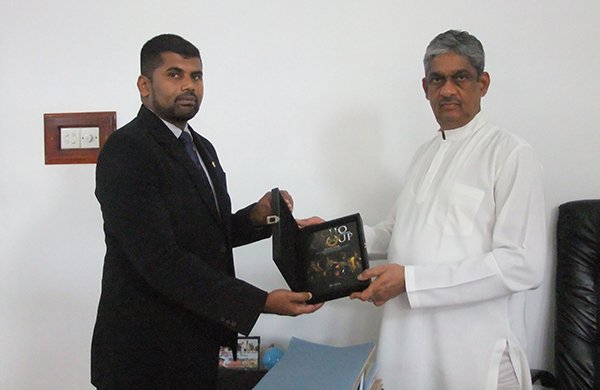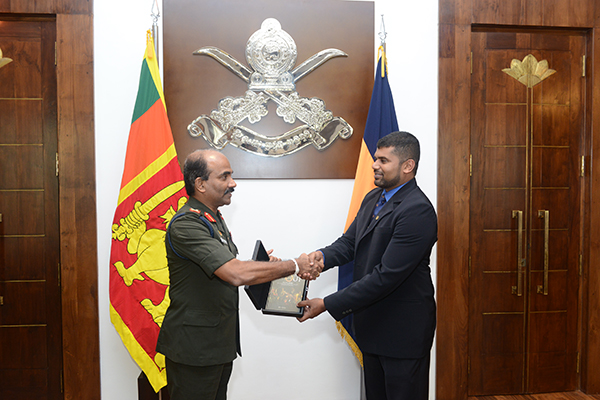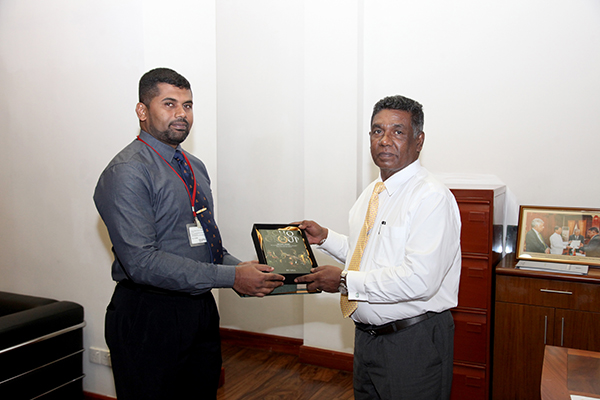He has handed over copies of the book, also named ‘Echo Group’, to Field Marshal Sarath Fonseka, the defence secretary and the Army commander.
About the author and the book:
Echo Group was the name of a Commando Group that fought during the Final Battle (2008 – 2009) against the LTTE in Sri Lanka. The book is written as a monologue by the author stating his personal experiences during the war. According to the author’s account the group had advanced 170 Kms in 350 days against the resistance of the LTTE. The book describes the ordeal and experiences the group confronted during the final battle. The group was commanded by Major Sha Hameed.
For Major Sha Hameed’s contribution during the final battle, he was awarded the Rana Wickrama and the Rana Sura Gallantry Medals.
Contents
Part One
Chapter 1 Early Days
Chapter 2 Awaiting orders to move
Chapter 3 Failures are the pillars of success
Chapter 4 Crossing the Rice Bowl
Chapter 5 Taking over the most feared sea base in
Vedithalathivu
Chapter 6 The Nachchikuda earth bunds
Chapter 7 Devils Point
Chapter 8 The prize of Pooneryn
Part Two
Chapter 9 Marching Towards Elephant Pass and
Negotiating Sinna Paranthan
Chapter 10 A – 9 Reopened after 23 years
Chapter 11 The battle at Puthukudirippu South
Chapter 12 The last battle I faced
Chapter 13 Conclusion
Background
To fight a guerrilla you need to be a guerrilla in his tactics, techniques and procedures in the battle field. This is the technique we adopted during the final battle conducted against the ruthless Liberation Tamil Tigers of Eelam commonly known as the LTTE, which in many knowledgeable assessments was far worse than Al Qaeda for that matter or any known terrorist organization that the world had ever known, an organization with the capability of employing suicide cadres at any place, any time and having light aircraft, armored tanks, artillery, a fleet of ships and some rudimentary submarines. This was apart from their fighting cadres on grounds backed up by a strong auxiliary force. This organization brainwashed by its leaders, who were in search of a separate state in this small country. The bloody war they waged for over 30 years saw a country devastated in matter of death and destruction.
This book will give you an in-depth idea as to how the final years of the war in Sri Lanka against the LTTE was fought by a Commando group with the minimum of technology and only the ingenuity of a soldier in the battle field – his wits and determination. In a war against a terrorist organization such as the LTTE, we hit them by using their own tactics, techniques in which they were eventually defeated.
PART ONE
Chapter 1 Early Days
This chapter contains the author’s School Life, training and emphasis on the Commando course. Further, it portrays the build up to the final battle and as to what stance the Sri Lankan government and the LTTE were.
Chapter 2 Awaiting Orders to Move
Chapter 2 describes the author’s appointment as an instructor at the Sri Lanka Military Academy with the importance to cadet training. While special emphasis is given to the eastern operations.
Chapter 3 Failures are the Pillars of Success
After a prolonged absence in battlefield due to commitments, the author explains the setback faced during the initial confrontation with the LTTE.
Chapter 4 Crossing the Rice Bowl
Considered as one of the most fortified tactical defence lines of the LTTE, the ‘Mannar rice Bowl’ was breached by the Security Forces after nearly six months of continuous operations. The Echo Group played one of the major roles in breaching the LTTE defense line.
Chapter 5 Taking Over the Most Feared Sea Base in
Vedithalathivu
Vedithalthivu was considered as the largest sea base of the LTTE in the west. Since the IPKF left in 1990 this sea base has been with the LTTE. It has not been captured by the Armed forces of Sri Lanka for 21 years. Though several attempts were made by the Army to capture the area it was in vain. The base had been a key strategic point in the LTTE held area. Apart from an operation base, training and illegal dealings with south Indian sympathizers were conducted through this base.
Chapter 6 The Nachchikuda Earth Bunds
Considered as one of the most tactically built earth bunds by the LTTE, to stop the advance of the Sri Lanka Armed forces. The ditch was about 10 feet high and about 7 feet wide. The height at some places was 12 feet. That was not all. It was constructed in a zigzag pattern. This chapter deals with as how the earth bund was overcome by the Security Forces.
Chapter 7 Devils Point
The chapter relates to the drawbacks by the group at devils point. The weather and the stiff resistance by the LTTE in order to safeguard their final town in the western front created a few setbacks to the group and how they overcame them.
Chapter 8 The Prize of Pooneryn
Pooneryn is situated in the northwest of Sri Lanka and in the tip of the main land. Ponneryn was connected by a causeway through the lagoon to Jaffna peninsula. After the escalation of the war, this causeway was damaged and after the completion of the Final Battle, it was fully restored. This was supposed to be a fortified location of the LTTE. From Pooneryn the Jaffna peninsula was controlled using long range guns of the LTTE. They were able to fire at the airstrip in Palaly, a town in the northern tip of Sri Lanka. In 1993 November, Pooneryn was taken over from the armed forces. From then onward it had been in the hands of the LTTE. The other important thing is that the sea route was controlled as well. The LTTE knew that if the Army captures Pooneryn, it will be a direct threat to Killinochchi and the fall of Killinochchi will be imminent.
PART TWO
Chapter 9 Marching Towards Elephant Pass and Negotiating
Sinna Paranthan
This was one of the most strategically constructed defense lines we ever came across. This was a sort of a defense line cum bund (DCB). UAV reports showed how well this bund was constructed. Taking on this DCB was a huge task. The aim of the LTTE was to hold on to the DCB as much as possible.
Chapter 10 A – 9 Reopened after 23 Years
“Elephant Pass, the gateway to the Jaffna peninsula is now under the total control of security forces”, news reports from the battlefront read. “Troops have also gained total control over the 325km long A-9, Jaffna-Kandy trunk road, after 23 years”, military sources further said.
These were the headlines. Elephant pass or commonly known as EPS was a strategically important location in Sri Lanka. It was a bottle neck and the gateway to enter Jaffna Peninsula from the mainland. The distance of the stretch was about 1.5kms. If there was a prominent place in this 30 year war to be named and where the most number of people had sacrificed their lives it was EPS. Any force holding on to this piece of ground had the advantage over its opponent. Time to time the Armed forces and the LTTE had been controlling this piece of ground.
Chapter 11 The Battle at Puthukudirippu South
This chapter reveals the group being airlifted to the eastern front in the final battle and the ordeal the group faced in order to re-consolidate the breached defense line.
Chapter 12 The Last Battle I Faced
The Security Forces and the LTTE were fighting the last phase of the final battle at this point. The chapter reveals the last confrontation the author encountered with the LTTE.
Chapter 13 Conclusion
We had walked nearly 170kms and it took us 345 days, at an average of 500 meters per day to finish the operations from Mannar with 58th Division against the resistance of the LTTE. For the last thirty years of the war in Sri Lanka there were unaccountable number of people, soldiers and LTTE cadres killed from both sides. The war took this island nation 50 years back in time. The destruction and trauma left by this bloody war will live with us for another few generations. Still I have nightmares and wake up in the night and take time off and sleep again. It is something we got to live with. The book that I have written will take you to the darkest side of what a soldier had to face during the operations in Sri Lanka against the LTTE. It is only just one man’s story. Everybody who took part in this war has his or her unique story to tell. The peace that we gained was not served on a tray, but was a hard fought win with a lot of sacrifices. Today everyone is benefitted by this and the country is no more called the blood drop of Asia. Many innocent lives were lost and a number of officers and soldiers had to sacrifice their lives. Enjoy the peace that has been given to you, cherish it as you have never done before and hold it so hard and never let it go. Let us not make the people who sacrificed their lives and who were injured think it was all in vain.









